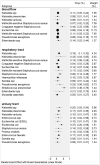Bacterial Co-Infection in Patients with COVID-19 Hospitalized (ICU and Not ICU): Review and Meta-Analysis
- PMID: 35884147
- PMCID: PMC9312179
- DOI: 10.3390/antibiotics11070894
Bacterial Co-Infection in Patients with COVID-19 Hospitalized (ICU and Not ICU): Review and Meta-Analysis
Abstract
The prevalence of patients hospitalized in ICUs with COVID-19 and co-infected by pathogenic bacteria is relevant in this study, considering the integrality of treatment. This systematic review assesses the prevalence of co-infection in patients admitted to ICUs with SARS-CoV-2 infection, using the PRISMA guidelines. We examined the results of the PubMed, Embase, and SciELO databases, searching for published English literature from December 2019 to December 2021. A total of 542 rec ords were identified, but only 38 were eligible and, and of these only 10 were included. The tabulated studies represented a sample group of 1394 co-infected patients. In total, 35%/138 of the patients were co-infected with Enterobacter spp., 27% (17/63) were co-infected with methicillin-sensitive Staphylococ cus aureus, 21% (84/404) were co-infected with Klebsiella spp., 16% (47/678) of patients were co-infected with coagulase-negative Staphylococcus, 13% (10/80) co-infected with Escherichia coli (ESBL), and 3% (30/1030) of patients were co-infected with Pseudomonas aeruginosa. The most common co-infections were related to blood flow; although in the urinary and respiratory tracts of patients Streptococcus pneumoniae was found in 57% (12/21) of patients, coagulase negative Staphylococcus in 44% (7/16) of patients, and Escherichia coli was found in 37% (11/29) of patients. The present research demonstrated that co-infections caused by bacteria in patients with COVID-19 are a concern.
Keywords: COVID-19; SARS-CoV-2; bacterial co-infections; public health.
Conflict of interest statement
The authors declare no conflict of interest.
Figures



References
Publication types
LinkOut - more resources
Full Text Sources
Miscellaneous

